Abstract
Mice were immunized with Cryptococcus neoformans serotype A capsular glucuronoxylomannan (GXM) conjugated to bovine serum albumin-adipic dihydrazide. Two splenocyte fusions yielded two monoclonal antibodies (MAbs) that were highly reactive in dot enzyme immunoassay, immunofluorescence, and sandwich enzyme immunoassay. The first MAb, BD-1 [immunoglobulin G1 (kappa) [IgG1(kappa)]], was GXM-A and GXM-D specific, whereas the second MAb, BA-4 (IgM), reacted with GXM-A and GXM-B. A third MAb, CD-6 [IgG1(kappa)], originated from mice immunized with O-deacetylated GXM-C-bovine serum albumin and reacted with GXMs of all four serotypes. Two of the MAbs (CD-6 and BD-1) were further characterized with chemically modified GXMs. Removal of glucuronosyl residues completely inhibited the binding of both MAbs, implicating (1----2)-beta-glucuronic acid as a key component of the epitope. Removal of (1----2)-beta-xylosyl residues decreased reactivity to an intermediate extent. O deacetylation led to a measurable decrease but had the least inhibitory effect of the three GXM derivatives tested. The combining site for these two MAbs appears to be a complex antigenic determinant involving more than one glycosidic residue.
Full text
PDF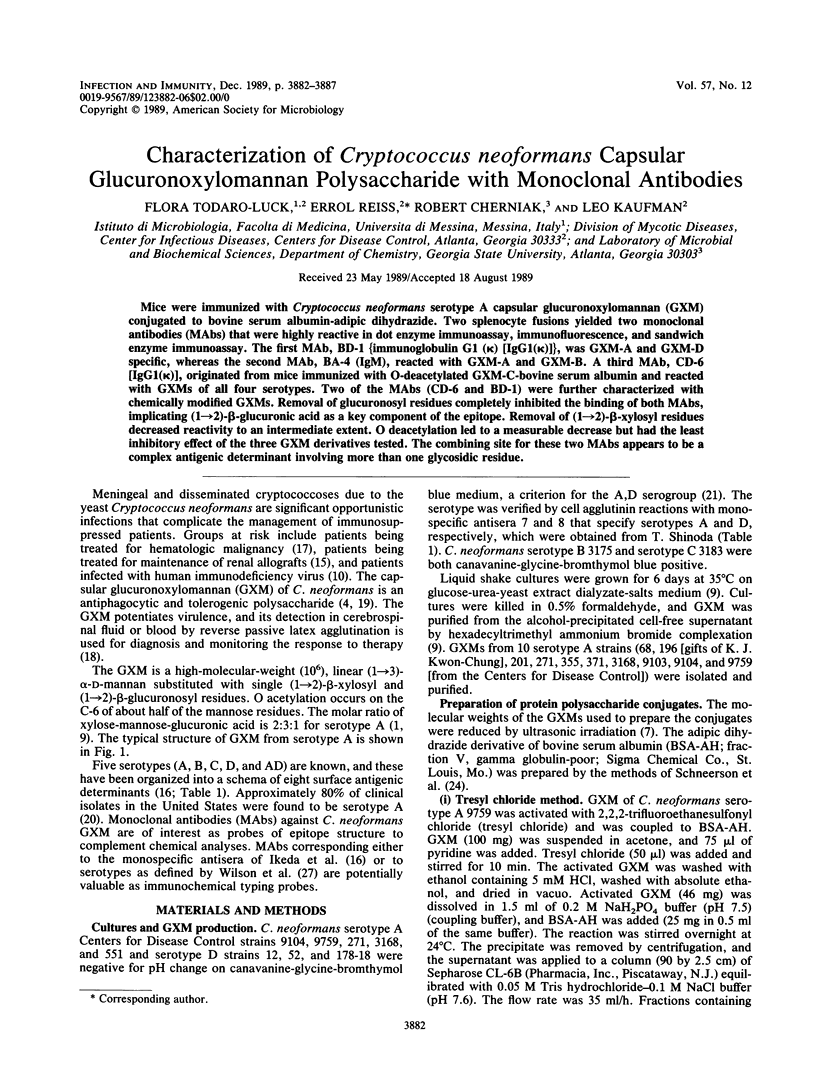
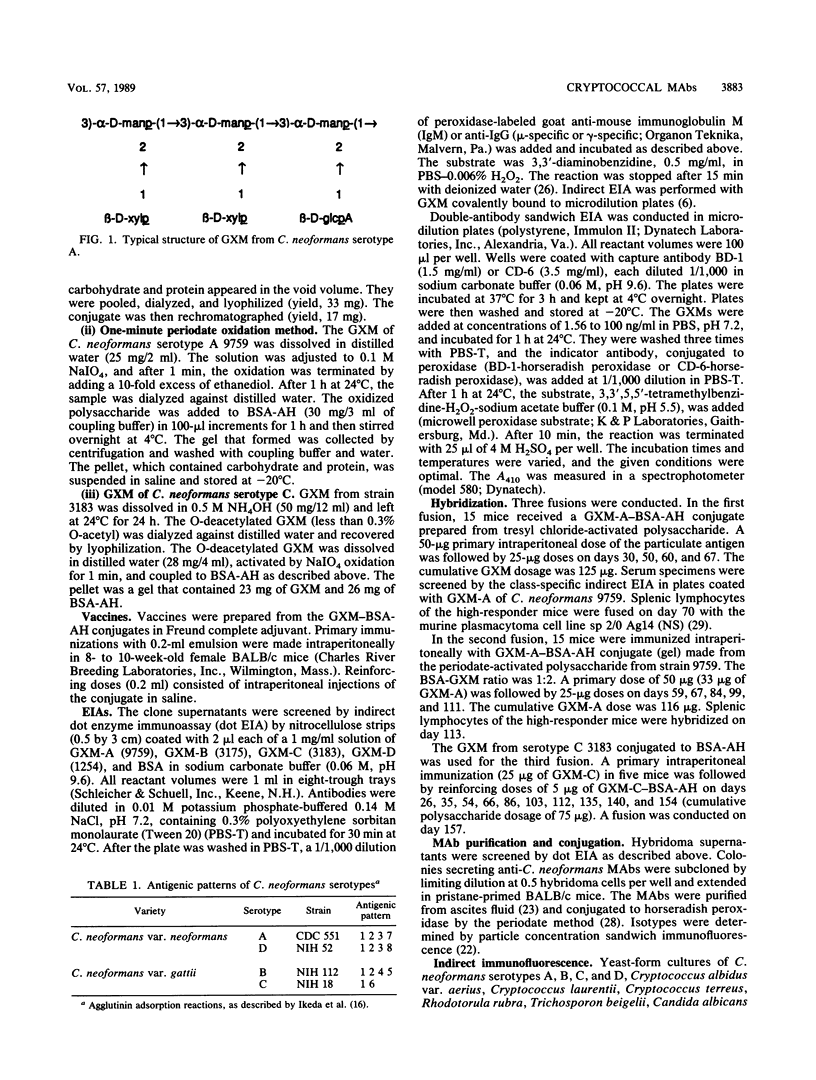
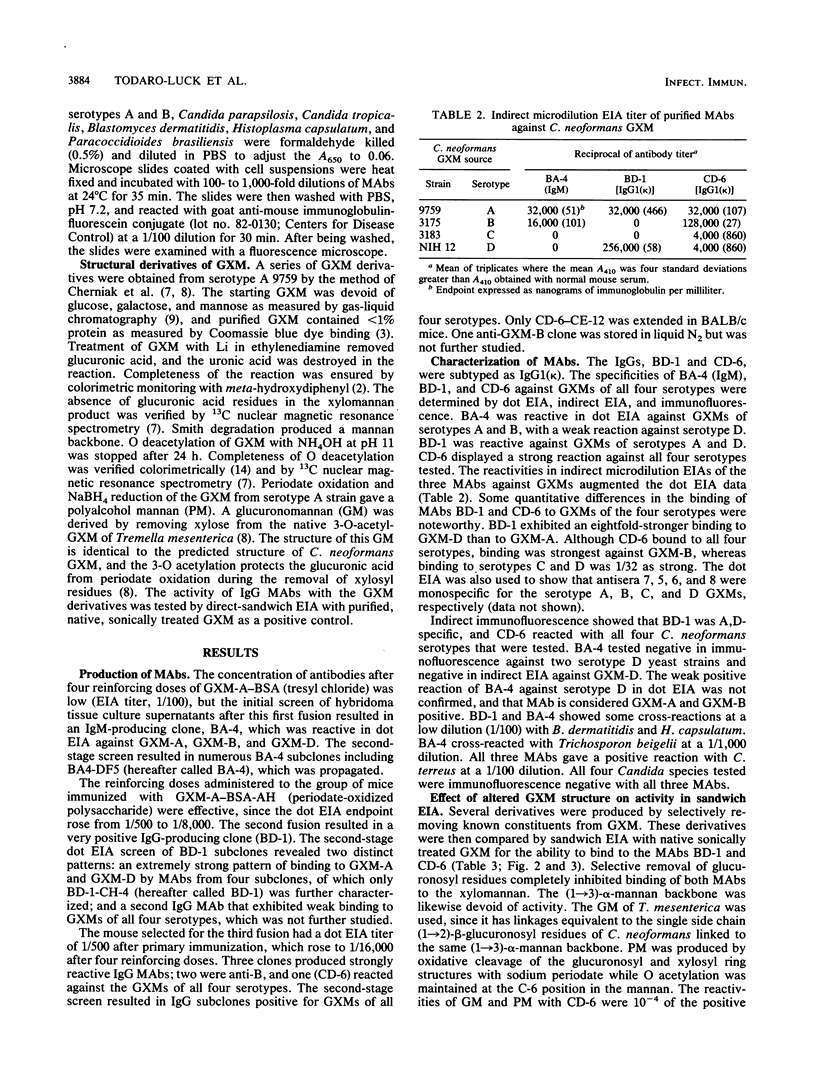
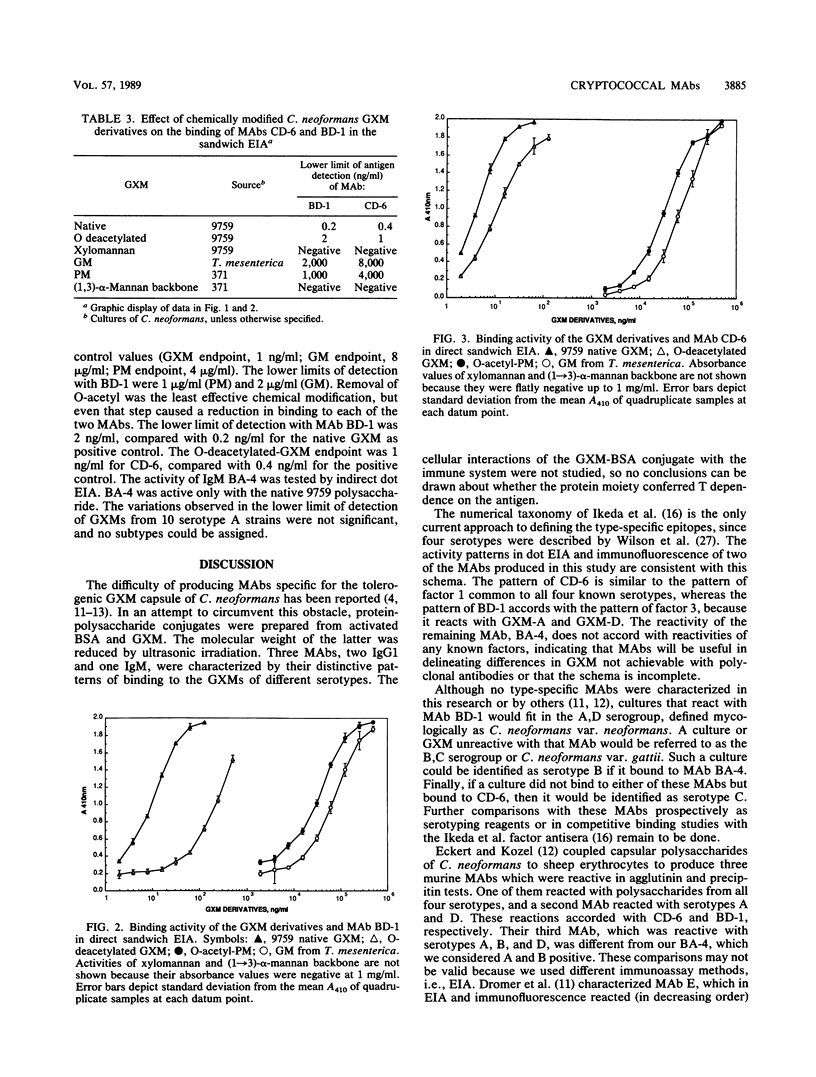
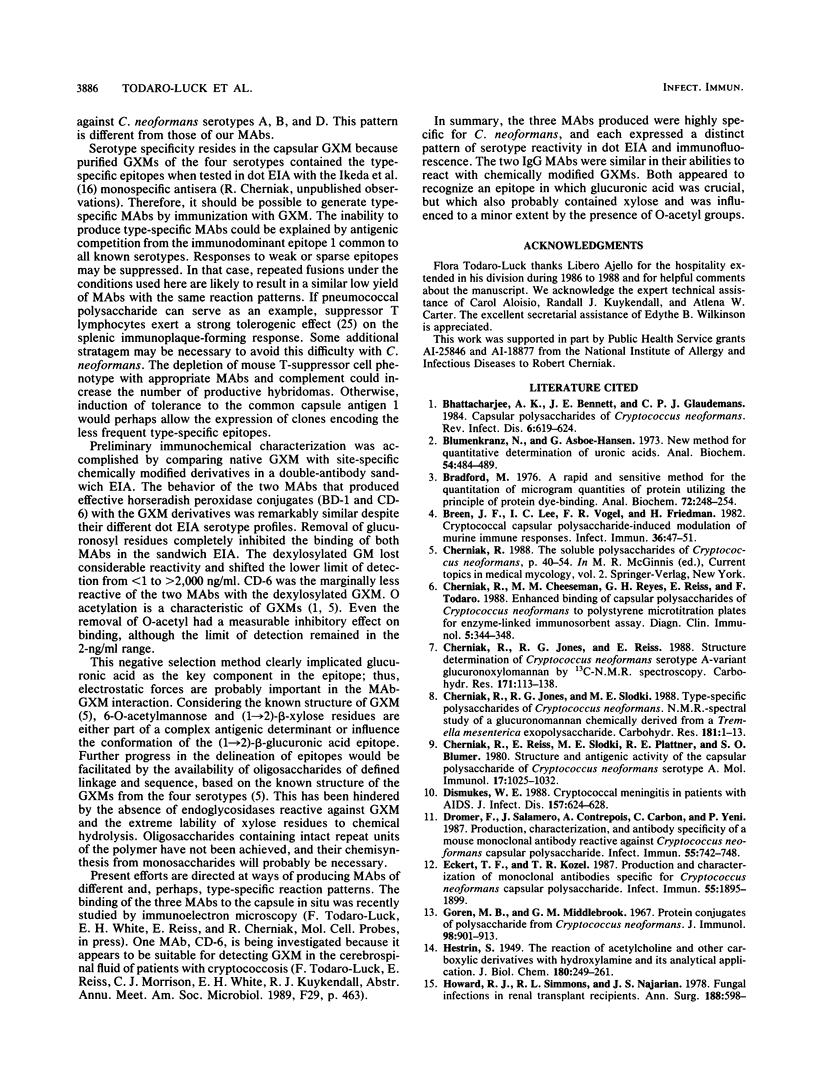
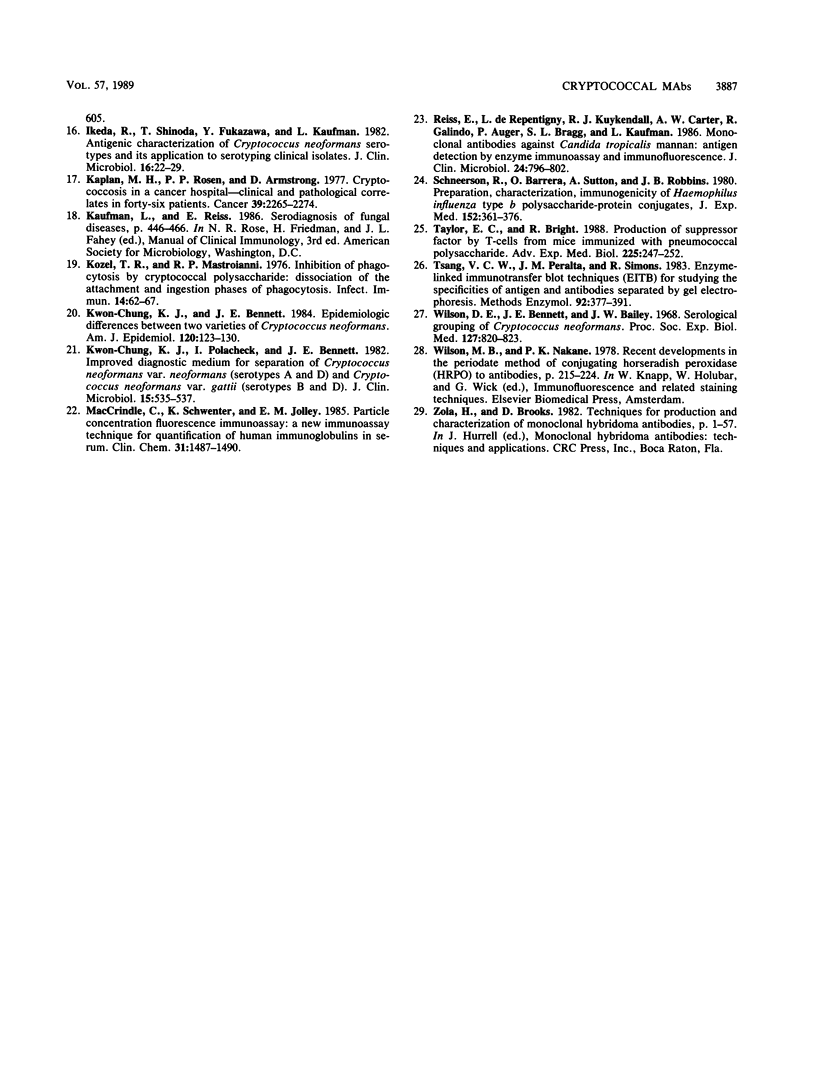
Selected References
These references are in PubMed. This may not be the complete list of references from this article.
- Bhattacharjee A. K., Bennett J. E., Glaudemans C. P. Capsular polysaccharides of Cryptococcus neoformans. Rev Infect Dis. 1984 Sep-Oct;6(5):619–624. doi: 10.1093/clinids/6.5.619. [DOI] [PubMed] [Google Scholar]
- Blumenkrantz N., Asboe-Hansen G. New method for quantitative determination of uronic acids. Anal Biochem. 1973 Aug;54(2):484–489. doi: 10.1016/0003-2697(73)90377-1. [DOI] [PubMed] [Google Scholar]
- Bradford M. M. A rapid and sensitive method for the quantitation of microgram quantities of protein utilizing the principle of protein-dye binding. Anal Biochem. 1976 May 7;72:248–254. doi: 10.1016/0003-2697(76)90527-3. [DOI] [PubMed] [Google Scholar]
- Breen J. F., Lee I. C., Vogel F. R., Friedman H. Cryptococcal capsular polysaccharide-induced modulation of murine immune responses. Infect Immun. 1982 Apr;36(1):47–51. doi: 10.1128/iai.36.1.47-51.1982. [DOI] [PMC free article] [PubMed] [Google Scholar]
- Cherniak R., Cheeseman M. M., Reyes G. H., Reiss E., Todaro F. Enhanced binding of capsular polysaccharides of Cryptococcus neoformans to polystyrene microtitration plates for enzyme-linked immunosorbent assay. Diagn Clin Immunol. 1988;5(6):344–348. [PubMed] [Google Scholar]
- Cherniak R., Jones R. G., Reiss E. Structure determination of Cryptococcus neoformans serotype A-variant glucuronoxylomannan by 13C-n.m.r. spectroscopy. Carbohydr Res. 1988 Jan 15;172(1):113–138. doi: 10.1016/s0008-6215(00)90846-2. [DOI] [PubMed] [Google Scholar]
- Cherniak R., Reiss E., Slodki M. E., Plattner R. D., Blumer S. O. Structure and antigenic activity of the capsular polysaccharide of Cryptococcus neoformans serotype A. Mol Immunol. 1980 Aug;17(8):1025–1032. doi: 10.1016/0161-5890(80)90096-6. [DOI] [PubMed] [Google Scholar]
- Cherniak R. Soluble polysaccharides of Cryptococcus neoformans. Curr Top Med Mycol. 1988;2:40–54. doi: 10.1007/978-1-4612-3730-3_2. [DOI] [PubMed] [Google Scholar]
- Dismukes W. E. Cryptococcal meningitis in patients with AIDS. J Infect Dis. 1988 Apr;157(4):624–628. doi: 10.1093/infdis/157.4.624. [DOI] [PubMed] [Google Scholar]
- Dromer F., Salamero J., Contrepois A., Carbon C., Yeni P. Production, characterization, and antibody specificity of a mouse monoclonal antibody reactive with Cryptococcus neoformans capsular polysaccharide. Infect Immun. 1987 Mar;55(3):742–748. doi: 10.1128/iai.55.3.742-748.1987. [DOI] [PMC free article] [PubMed] [Google Scholar]
- Eckert T. F., Kozel T. R. Production and characterization of monoclonal antibodies specific for Cryptococcus neoformans capsular polysaccharide. Infect Immun. 1987 Aug;55(8):1895–1899. doi: 10.1128/iai.55.8.1895-1899.1987. [DOI] [PMC free article] [PubMed] [Google Scholar]
- Goren M. B., Middlebrook G. M. Protein conjugates of polysaccharide from Cryptococcus neoforman s. J Immunol. 1967 May;98(5):901–913. [PubMed] [Google Scholar]
- HESTRIN S. The reaction of acetylcholine and other carboxylic acid derivatives with hydroxylamine, and its analytical application. J Biol Chem. 1949 Aug;180(1):249–261. [PubMed] [Google Scholar]
- Howard R. J., Simmons R. L., Najarian J. S. Fungal infections in renal transplant recipients. Ann Surg. 1978 Nov;188(5):598–605. doi: 10.1097/00000658-197811000-00003. [DOI] [PMC free article] [PubMed] [Google Scholar]
- Ikeda R., Shinoda T., Fukazawa Y., Kaufman L. Antigenic characterization of Cryptococcus neoformans serotypes and its application to serotyping of clinical isolates. J Clin Microbiol. 1982 Jul;16(1):22–29. doi: 10.1128/jcm.16.1.22-29.1982. [DOI] [PMC free article] [PubMed] [Google Scholar]
- Kaplan M. H., Rosen P. P., Armstrong D. Cryptococcosis in a cancer hospital: clinical and pathological correlates in forty-six patients. Cancer. 1977 May;39(5):2265–2274. doi: 10.1002/1097-0142(197705)39:5<2265::aid-cncr2820390546>3.0.co;2-x. [DOI] [PubMed] [Google Scholar]
- Kozel T. R., Mastroianni R. P. Inhibition of phagocytosis by cryptococcal polysaccharide: dissociation of the attachment and ingestion phases of phagocytosis. Infect Immun. 1976 Jul;14(1):62–67. doi: 10.1128/iai.14.1.62-67.1976. [DOI] [PMC free article] [PubMed] [Google Scholar]
- Kwon-Chung K. J., Bennett J. E. Epidemiologic differences between the two varieties of Cryptococcus neoformans. Am J Epidemiol. 1984 Jul;120(1):123–130. doi: 10.1093/oxfordjournals.aje.a113861. [DOI] [PubMed] [Google Scholar]
- Kwon-Chung K. J., Polacheck I., Bennett J. E. Improved diagnostic medium for separation of Cryptococcus neoformans var. neoformans (serotypes A and D) and Cryptococcus neoformans var. gattii (serotypes B and C). J Clin Microbiol. 1982 Mar;15(3):535–537. doi: 10.1128/jcm.15.3.535-537.1982. [DOI] [PMC free article] [PubMed] [Google Scholar]
- MacCrindle C., Schwenzer K., Jolley M. E. Particle concentration fluorescence immunoassay: a new immunoassay technique for quantification of human immunoglobulins in serum. Clin Chem. 1985 Sep;31(9):1487–1490. [PubMed] [Google Scholar]
- Reiss E., de Repentigny L., Kuykendall R. J., Carter A. W., Galindo R., Auger P., Bragg S. L., Kaufman L. Monoclonal antibodies against Candida tropicalis mannan: antigen detection by enzyme immunoassay and immunofluorescence. J Clin Microbiol. 1986 Nov;24(5):796–802. doi: 10.1128/jcm.24.5.796-802.1986. [DOI] [PMC free article] [PubMed] [Google Scholar]
- Schneerson R., Barrera O., Sutton A., Robbins J. B. Preparation, characterization, and immunogenicity of Haemophilus influenzae type b polysaccharide-protein conjugates. J Exp Med. 1980 Aug 1;152(2):361–376. doi: 10.1084/jem.152.2.361. [DOI] [PMC free article] [PubMed] [Google Scholar]
- Taylor C. E., Bright R. Production of suppressor factor by T-cells from mice immunized with pneumococcal polysaccharide. Adv Exp Med Biol. 1987;225:247–252. doi: 10.1007/978-1-4684-5442-0_22. [DOI] [PubMed] [Google Scholar]
- Tsang V. C., Peralta J. M., Simons A. R. Enzyme-linked immunoelectrotransfer blot techniques (EITB) for studying the specificities of antigens and antibodies separated by gel electrophoresis. Methods Enzymol. 1983;92:377–391. doi: 10.1016/0076-6879(83)92032-3. [DOI] [PubMed] [Google Scholar]
- Wilson D. E., Bennett J. E., Bailey J. W. Serologic grouping of Cryptococcus neoformans. Proc Soc Exp Biol Med. 1968 Mar;127(3):820–823. doi: 10.3181/00379727-127-32812. [DOI] [PubMed] [Google Scholar]


